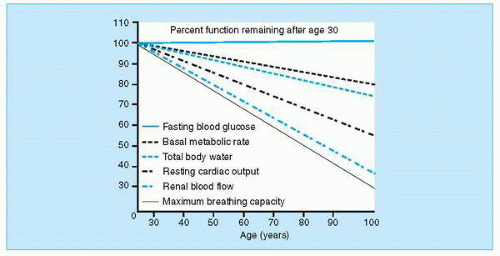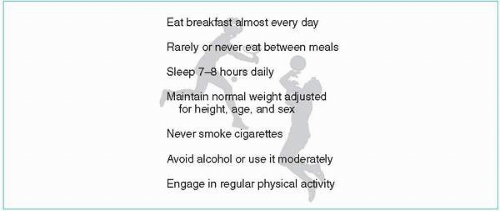Early Adulthood: Physical Health
Most young adults in the United States are in good physical condition.
The health habits developed during these years are reliable indicators of future health conditions.
Pregnancy and childbirth are significant physical events during these years.
The condition of the cardiovascular and pulmonary systems depends on activity level, high versus low fat concentrations, and the decision whether to smoke.
Prevention measures to safeguard healthy young people are becoming more widely adopted.
The goal of health promotion is to improve one’s well-being through healthy lifestyle choices.
TERMS
Cardiovascular system
Musculoskeletal system
Primary prevention
Pulmonary system
Humans are at the peak of physical development and performance between ages 20 and 30. The built-in reserve of vital capacity in major organs and biological systems remains robust until about age 30, after which it experiences varying rates of decline (Figure 65-1). The health habits that individuals develop during this period are excellent predictors of how humans will weather the physical changes and diseases that typically emerge in the middle and later years. Figure 65-2 lists the seven health habits most closely associated with good health.
Body Mass, Height, and Weight
The average woman in the United States is 5 feet, 4 inches, tall, and reaches that height by age 18. Men reach the average height of 5 feet, 9 inches, at age 20. The typical weight gain of 10 to 15 pounds between ages 18 and 30 is largely due to the maturing of muscles, bones, and internal organs and an increase in fatty tissue. Overindulgence in food and alcohol is the major reason for obesity during this period.
Skin, Hair, and Teeth
As total body water begins to decrease, and time spent in the sun accumulates, skin becomes drier. Male pattern balding, which begins with hair loss at the crown and is genetically determined, begins in men’s twenties and thirties. Wisdom teeth often cause problems that lead to their removal.
Musculoskeletal System
Fusion of the epiphyses of the long bones occurs between ages 18 and 25, which is also the peak of muscle performance. After age 26, muscle strength begins to decline and reaction time levels off. Declines in muscle mass and body water content may be masked by an increase in fatty tissue, giving a false impression of vigor. Decline in water content in the joints results in small skeletal changes after age 30, increasing a person’s vulnerability to knee, ankle, and shoulder injuries.
 The average woman in the United States is 5 feet, 4 inches, tall, and reaches that height by age 18. Men reach the average height of 5 feet, 9 inches, at age 20.
The average woman in the United States is 5 feet, 4 inches, tall, and reaches that height by age 18. Men reach the average height of 5 feet, 9 inches, at age 20.Stay updated, free articles. Join our Telegram channel

Full access? Get Clinical Tree


Get Clinical Tree app for offline access



